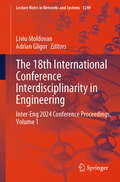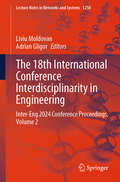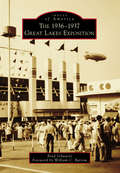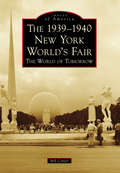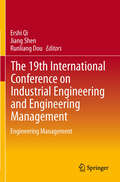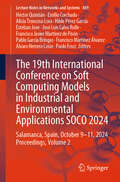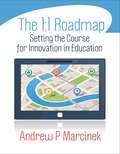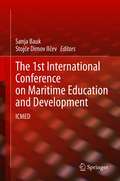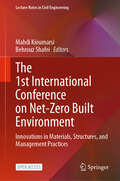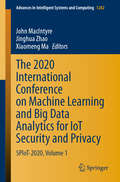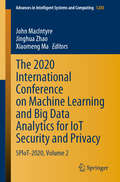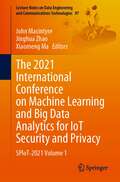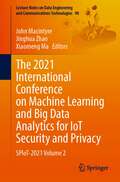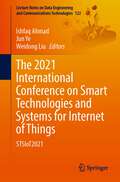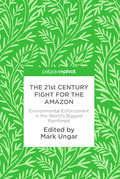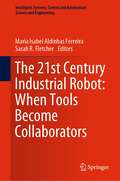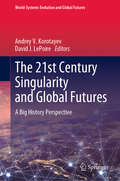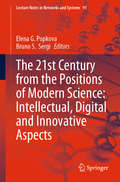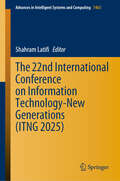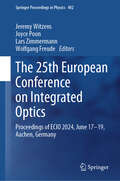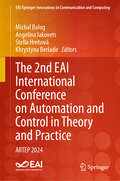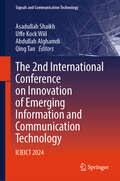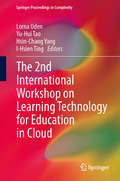- Table View
- List View
The 18th International Conference Interdisciplinarity in Engineering: Inter-Eng 2024 Conference Proceedings, Volume 1 (Lecture Notes in Networks and Systems #1249)
by Liviu Moldovan Adrian GligorThis book contains research papers that were accepted for presentation at the 18th International Conference on Interdisciplinarity in Engineering—INTER-ENG 2024, which was held on 3–4 October 2024, in the city of Targu Mures, Romania. The general scope of the conference “An effective digital-green transition for a more competitive European industry” is proposing a new approach related to the development of a new generation of smart factories grounded on the manufacturing and assembly process digitalization. It is related to advance manufacturing technology, lean manufacturing, sustainable manufacturing, additive manufacturing, manufacturing tools and equipment. It is a leading international professional and scientific forum of great interest for engineers and scientists who can read in this book research works contributions and recent developments as well as current practices in advanced fields of engineering.
The 18th International Conference Interdisciplinarity in Engineering: Inter-Eng 2024 Conference Proceedings, Volume 2 (Lecture Notes in Networks and Systems #1250)
by Liviu Moldovan Adrian GligorThis book contains research papers that were accepted for presentation at the 18th International Conference on Interdisciplinarity in Engineering—INTER-ENG 2024, which was held on 3–4 October 2024, in the city of Targu Mures, Romania. The general scope of the conference “An effective digital-green transition for a more competitive European industry” is proposing a new approach related to the development of a new generation of smart factories grounded on the manufacturing and assembly process digitalization. It is related to advance manufacturing technology, lean manufacturing, sustainable manufacturing, additive manufacturing, manufacturing tools and equipment. It is a leading international professional and scientific forum of great interest for engineers and scientists who can read in this book research works contributions and recent developments as well as current practices in advanced fields of engineering.
The 1936-1937 Great Lakes Exposition (Images of America)
by Brad Schwartz William C. BarrowThe Great Lakes Exposition was held in Cleveland during the summers of 1936 and 1937, drawing seven million visitors over its two-year run. The exposition was intended to observe the city's centennial anniversary and to celebrate the Great Lakes Region. It was also hoped that it would help lift the city's economy out of the Great Depression. The exposition boasted a staggering array of ever-changing national-level attractions and feature events. In a single day, exposition visitors could experience the latest technological innovations; see a world-class aquatics show; watch a Shakespearean play; ride in a blimp; and hear the music, taste the food, view the architecture, and experience the culture of 40 of the world's countries.
The 1939-1940 New York World's Fair: The World of Tomorrow (Images of America)
by Bill CotterThe World of Tomorrow
The 19th International Conference on Industrial Engineering and Engineering Management: Engineering Management
by Ershi Qi Jiang Shen Runliang DouThe International Conference on Industrial Engineering and Engineering Management is sponsored by the Chinese Industrial Engineering Institution, CMES, which is the only national-level academic society for Industrial Engineering. The conference is held annually as the major event in this arena. Being the largest and the most authoritative international academic conference held in China, it provides an academic platform for experts and entrepreneurs in the areas of international industrial engineering and management to exchange their research findings. Many experts in various fields from China and around the world gather together at the conference to review, exchange, summarize and promote their achievements in the fields of industrial engineering and engineering management. For example, some experts pay special attention to the current state of the application of related techniques in China as well as their future prospects, such as green product design, quality control and management, supply chain and logistics management to address the need for, amongst other things low-carbon, energy-saving and emission-reduction. They also offer opinions on the outlook for the development of related techniques. The proceedings offers impressive methods and concrete applications for experts from colleges and universities, research institutions and enterprises who are engaged in theoretical research into industrial engineering and engineering management and its applications. As all the papers are of great value from both an academic and a practical point of view, they also provide research data for international scholars who are investigating Chinese style enterprises and engineering management.
The 19th International Conference on Soft Computing Models in Industrial and Environmental Applications SOCO 2024: Salamanca, Spain, October 9-11, 2024 Proceedings, Volume 1 (Lecture Notes in Networks and Systems #888)
by Héctor Quintián Emilio Corchado Francisco Javier Martínez de Pisón Hilde Pérez García Francisco Martínez Álvarez Alicia Troncoso Lora Pablo García Bringas Esteban Jove José Luis Calvo Rolle Paolo Fosci Álvaro Herrero CosíoThis volume of Advances in Intelligent and Soft Computing contains accepted papers presented at the SOCO 2024 conference held in the beautiful and historic city of Salamanca (Spain) in October 2024. Soft computing represents a collection or set of computational techniques in machine learning, computer science, and some engineering disciplines that investigate, simulate, and analyze very complex issues and phenomena. After a thorough peer-review process, the 18th SOCO 2023 International Program Committee selected 62 papers for publication in these conference proceedings, representing an acceptance rate of 50%. In this relevant edition, a particular emphasis was put on organizing special sessions. Four special sessions were organized related to relevant topics such as Machine Learning and Computer Vision in Industry 4.0, Intelligent Models and Frameworks for Smart Agriculture and Green Economy, Computational Intelligence Applied to Modelling and Control of Engineering Systems, and Applied Machine Learning (2nd Edition). The selection of papers was extremely rigorous to maintain the high quality of the conference. We want to thank the members of the Program Committees for their hard work during the reviewing process. This is a crucial process for creating a high-standard conference; the SOCO conference would not exist without their help.
The 19th International Conference on Soft Computing Models in Industrial and Environmental Applications SOCO 2024: Salamanca, Spain, October 9-11, 2024 Proceedings, Volume 2 (Lecture Notes in Networks and Systems #889)
by Héctor Quintián Emilio Corchado Francisco Javier Martínez de Pisón Hilde Pérez García Francisco Martínez Álvarez Alicia Troncoso Lora Pablo García Bringas Esteban Jove José Luis Calvo Rolle Paolo Fosci Álvaro Herrero CosíoThis volume of Advances in Intelligent and Soft Computing contains accepted papers presented at the SOCO 2024 conference held in the beautiful and historic city of Salamanca (Spain) in October 2024. Soft computing represents a collection or set of computational techniques in machine learning, computer science, and some engineering disciplines that investigate, simulate, and analyze very complex issues and phenomena. After a thorough peer-review process, the 18th SOCO 2023 International Program Committee selected 62 papers for publication in these conference proceedings, representing an acceptance rate of 50%. In this relevant edition, a particular emphasis was put on organizing special sessions. Four special sessions were organized related to relevant topics such as Machine Learning and Computer Vision in Industry 4.0, Intelligent Models and Frameworks for Smart Agriculture and Green Economy, Computational Intelligence Applied to Modelling and Control of Engineering Systems, and Applied Machine Learning (2nd Edition). The selection of papers was extremely rigorous to maintain the high quality of the conference. We want to thank the members of the Program Committees for their hard work during the reviewing process. This is a crucial process for creating a high-standard conference; the SOCO conference would not exist without their help.
The 1: Setting the Course for Innovation in Education
by Andrew P. MarcinekTechnology is more than just “Computer Class;” it is a literacy that must be threaded throughout the fabric of a school. In a 1:1 environment, you’re preparing students to be responsible citizens of the physical and digital worlds. But it’s easy to get overwhelmed with devices; you have to have a plan for technology that keeps learning at center stage. Here you’ll find a solid plan for designing a technology initiative that fuels student learning. Real-life examples, lessons, and interviews with stakeholders show you Why a 1:1 program is not only achievable but also beneficial and necessary How to choose the right devices The best ways to prepare teachers through professional development Best practices for instruction and personalization in a 1:1 environment It’s more essential than ever to integrate digital and information literacy into the fabric of our schools. This practical resource will get you started on the journey.
The 1: Setting the Course for Innovation in Education
by Andrew P. MarcinekTechnology is more than just “Computer Class;” it is a literacy that must be threaded throughout the fabric of a school. In a 1:1 environment, you’re preparing students to be responsible citizens of the physical and digital worlds. But it’s easy to get overwhelmed with devices; you have to have a plan for technology that keeps learning at center stage. Here you’ll find a solid plan for designing a technology initiative that fuels student learning. Real-life examples, lessons, and interviews with stakeholders show you Why a 1:1 program is not only achievable but also beneficial and necessary How to choose the right devices The best ways to prepare teachers through professional development Best practices for instruction and personalization in a 1:1 environment It’s more essential than ever to integrate digital and information literacy into the fabric of our schools. This practical resource will get you started on the journey.
The 1st International Conference on Maritime Education and Development: ICMED
by Stojče Dimov Ilčev Sanja BaukThis book presents the proceedings of the 1st International Conference on Maritime Education and Development. The conference exchanges knowledge, experiences and ideas in the domain of maritime education and development, with the ultimate goal of generating new knowledge and implementing smart strategies and actions. Topics include the 4th Industrial Revolution (4IR); unmanned air/sea surface/underwater vehicles (UxV); the digital divide and Internet accessibility; digital infrastructure; IMO E-navigation strategy; smart-ship concept; automation and digitalization; cyber security; and maritime future. This proceedings pertains to researchers, academics, students, and professionals in the realm of maritime education and development.
The 1st International Conference on Net-Zero Built Environment: Innovations in Materials, Structures, and Management Practices (Lecture Notes in Civil Engineering #237)
by Mahdi Kioumarsi Behrouz ShafeiThis open access book provides the latest fundamental and practical advances in reducing the built environment’s carbon footprint based on a collection of papers presented at the 1st International Conference on Net-Zero Built Environment: Innovations in Materials, Structures, and Management Practices, held June 19-21, 2024, in Oslo, Norway. The volume presents research investigations and case studies spanning five interrelated domains: New materials and material preparation processes for zero (or negative) carbon footprint Robotic construction technologies for minimum formwork and on-site activities Novel structural designs and details for optimal performance with the least material usage Advanced condition assessment and health monitoring methods for the longest service life Innovative life-cycle analysis and policy-making strategies for effective civil infrastructure management
The 2020 International Conference on Machine Learning and Big Data Analytics for IoT Security and Privacy: SPIoT-2020, Volume 1 (Advances in Intelligent Systems and Computing #1282)
by John MacIntyre Jinghua Zhao Xiaomeng MaThis book presents the proceedings of The 2020 International Conference on Machine Learning and Big Data Analytics for IoT Security and Privacy (SPIoT-2020), held in Shanghai, China, on November 6, 2020. Due to the COVID-19 outbreak problem, SPIoT-2020 conference was held online by Tencent Meeting. It provides comprehensive coverage of the latest advances and trends in information technology, science and engineering, addressing a number of broad themes, including novel machine learning and big data analytics methods for IoT security, data mining and statistical modelling for the secure IoT and machine learning-based security detecting protocols, which inspire the development of IoT security and privacy technologies. The contributions cover a wide range of topics: analytics and machine learning applications to IoT security; data-based metrics and risk assessment approaches for IoT; data confidentiality and privacy in IoT; and authentication and access control for data usage in IoT. Outlining promising future research directions, the book is a valuable resource for students, researchers and professionals and provides a useful reference guide for newcomers to the IoT security and privacy field.
The 2020 International Conference on Machine Learning and Big Data Analytics for IoT Security and Privacy: SPIoT-2020, Volume 2 (Advances in Intelligent Systems and Computing #1283)
by John MacIntyre Jinghua Zhao Xiaomeng MaThis book presents the proceedings of The 2020 International Conference on Machine Learning and Big Data Analytics for IoT Security and Privacy (SPIoT-2020), held in Shanghai, China, on November 6, 2020. Due to the COVID-19 outbreak problem, SPIoT-2020 conference was held online by Tencent Meeting. It provides comprehensive coverage of the latest advances and trends in information technology, science and engineering, addressing a number of broad themes, including novel machine learning and big data analytics methods for IoT security, data mining and statistical modelling for the secure IoT and machine learning-based security detecting protocols, which inspire the development of IoT security and privacy technologies. The contributions cover a wide range of topics: analytics and machine learning applications to IoT security; data-based metrics and risk assessment approaches for IoT; data confidentiality and privacy in IoT; and authentication and access control for data usage in IoT. Outlining promising future research directions, the book is a valuable resource for students, researchers and professionals and provides a useful reference guide for newcomers to the IoT security and privacy field.
The 2021 International Conference on Machine Learning and Big Data Analytics for IoT Security and Privacy: SPIoT-2021 Volume 1 (Lecture Notes on Data Engineering and Communications Technologies #97)
by John Macintyre Jinghua Zhao Xiaomeng MaThis book presents the proceedings of the 2020 2nd International Conference on Machine Learning and Big Data Analytics for IoT Security and Privacy (SPIoT-2021), online conference, on 30 October 2021. It provides comprehensive coverage of the latest advances and trends in information technology, science and engineering, addressing a number of broad themes, including novel machine learning and big data analytics methods for IoT security, data mining and statistical modelling for the secure IoT and machine learning-based security detecting protocols, which inspire the development of IoT security and privacy technologies. The contributions cover a wide range of topics: analytics and machine learning applications to IoT security; data-based metrics and risk assessment approaches for IoT; data confidentiality and privacy in IoT; and authentication and access control for data usage in IoT. Outlining promising future research directions, the book is a valuable resource for students, researchers and professionals and provides a useful reference guide for newcomers to the IoT security and privacy field.
The 2021 International Conference on Machine Learning and Big Data Analytics for IoT Security and Privacy: SPIoT-2021 Volume 2 (Lecture Notes on Data Engineering and Communications Technologies #98)
by John Macintyre Jinghua Zhao Xiaomeng MaThis book presents the proceedings of the 2020 2nd International Conference on Machine Learning and Big Data Analytics for IoT Security and Privacy (SPIoT-2021), online conference, on 30 October 2021. It provides comprehensive coverage of the latest advances and trends in information technology, science and engineering, addressing a number of broad themes, including novel machine learning and big data analytics methods for IoT security, data mining and statistical modelling for the secure IoT and machine learning-based security detecting protocols, which inspire the development of IoT security and privacy technologies. The contributions cover a wide range of topics: analytics and machine learning applications to IoT security; data-based metrics and risk assessment approaches for IoT; data confidentiality and privacy in IoT; and authentication and access control for data usage in IoT. Outlining promising future research directions, the book is a valuable resource for students, researchers and professionals and provides a useful reference guide for newcomers to the IoT security and privacy field.
The 2021 International Conference on Smart Technologies and Systems for Internet of Things: STSIoT2021 (Lecture Notes on Data Engineering and Communications Technologies #122)
by Weidong Liu Jun Ye Ishfaq AhmadThis book contains papers presented at the 2021 International Conference on Smart Technologies and Systems for Internet of Things, held on November 26–27, 2021, in Shanghai, China. It covers topics like distributed processing for sensor data in CPS networks, approximate reasoning and pattern recognition for CPS networks, distributed processing in mobile networking, data analytics for social media sensor data integration, data platforms for efficient integration with CPS networks, virtualized and cloud-oriented resources for data processing for CPS networks, machine learning algorithms for CPS networks, data security and privacy in CPS networks, sensor fusion algorithms, sensor signal processing, data acquisition and preprocessing technology, intelligent computing, data mining methods and algorithms, big data system solutions and tools platform, intelligent control and intelligent management, and operational situation awareness utilizing big data-driven intelligence. It caters to postgraduate students, researchers, and practitioners specializing and working in related areas.
The 21st Century Fight for the Amazon
by Mark UngarThis book is the most updated and comprehensive look at efforts to protect the Amazon, home to half of the world's remaining tropical forests. In the past five years, the Basin's countries have become the cutting edge of environmental enforcement through formation of constitutional protections, military operations, stringent laws, police forces, judicial procedures and societal efforts that together break through barriers that have long restrained decisive action. Even such advances, though, struggle to curb devastation by oil extraction, mining, logging, dams, pollution, and other forms of ecocide. In every country, environmental protection is crippled by politics, bureaucracy, unclear laws, untrained officials, small budgets, regional rivalries, inter-ministerial competition, collusion with criminals, and the global demand for oils and minerals. Countries are better at creating environmental agencies, that is, than making sure that they work. This book explains why, with country studies written by those on the front lines--from national enforcement directors to biologists and activists.
The 21st Century Industrial Robot: When Tools Become Collaborators (Intelligent Systems, Control and Automation: Science and Engineering #81)
by Maria Isabel Aldinhas Ferreira Sarah R. FletcherThis book aims to discuss the technical and ethical challenges posed by the present technological framework and to highlight the fundamental role played by human-centred design and human factors in the definition of robotic architectures for human–robot collaboration.The book gives an updated overview of the most recent robotic technology, conceived and designed to collaborate with human beings in industrial working scenarios. The technological development of robotics over the last years and the fast evolution of AI, machine learning and IoT have paved the way for applications that extend far beyond the typical use of robots performing repetitive tasks in exclusive spaces. In this new technological paradigm that is expected to drive the robotics market in the coming years, robots and workers will coexist in the same workplace, sharing not only this lived space, but also the roles and functions inherent to a process of production, merging the benefits of automated and manual performing. However, having robots cooperating in real time with workers, responding in a physical, psychological and social adequate way, requires a human-centred design that not only calls for high safety standards regulating the quality of human–robot interaction, but also demands the robot's fine-grained perception and awareness of the dynamics of its surrounding environment, namely the behaviours of their human peers—their expected actions/responses—fostering the necessary collaborative efforts towards the accomplishment of the tasks to be executed.
The 21st Century Singularity and Global Futures: A Big History Perspective (World-Systems Evolution and Global Futures)
by Andrey V. Korotayev David J. LePoireThis book introduces a 'Big History' perspective to understand the acceleration of social, technological and economic trends towards a near-term singularity, marking a radical turning point in the evolution of our planet. It traces the emergence of accelerating innovation rates through global history and highlights major historical transformations throughout the evolution of life, humans, and civilization. The authors pursue an interdisciplinary approach, also drawing on concepts from physics and evolutionary biology, to offer potential models of the underlying mechanisms driving this acceleration, along with potential clues on how it might progress. The contributions gathered here are divided into five parts, the first of which studies historical mega-trends in relation to a variety of aspects including technology, population, energy, and information. The second part is dedicated to a variety of models that can help understand the potential mechanisms, and support extrapolation. In turn, the third part explores various potential future scenarios, along with the paths and decisions that are required. The fourth part presents philosophical perspectives on the potential deeper meaning and implications of the trend towards singularity, while the fifth and last part discusses the implications of the Search for Extraterrestrial Intelligence (SETI). Given its scope, the book will appeal to scholars from various disciplines interested in historical trends, technological change and evolutionary processes.
The 21st Century from the Positions of Modern Science: Intellectual, Digital and Innovative Aspects (Lecture Notes in Networks and Systems #91)
by Elena G. Popkova Bruno S. SergiThese proceedings gather the best papers presented at the “10th International Scientific and Practical Conference – the 21st Century from the Positions of Modern Science: Intellectual, Digital and Innovative Aspects,” which was organized by the non-profit organization “Institute of Scientific Communications.” The conference took place on May 23–24 in Nizhny Novgorod, Russia, with support from Minin Nizhny Novgorod State Pedagogical University. The chief advantage of these proceedings are their multidisciplinary character – they include articles and empirical studies addressing various fields, including economics, the social sciences, and law. Accordingly, the target audience is broad, covering scholars, researchers, independent experts, entrepreneurs, and government workers, who are interested in issues concerning: measuring and accelerating socio-economic development; the formation and evolution of the digital society and digital economy; the role of economic systems and economic subjects in the 21st-century technological revolution (the fourth industrial revolution); development and implementation of AI; development and application of intellectual resources in economic activities; and innovations in the economy.
The 22nd International Conference on Information Technology-New Generations (Advances in Intelligent Systems and Computing #1463)
by Shahram LatifiThis book covers technical contributions that have been submitted, reviewed and presented at the 22nd annual event of International conference on Information Technology: New Generations (ITNG) The applications of advanced information technology to such domains as astronomy, biology, education, geosciences, security and health care are among topics of relevance to ITNG. Visionary ideas, theoretical and experimental results, as well as prototypes, designs, and tools that help the information readily flow to the user are of special interest. Machine Learning, Robotics, High Performance Computing, and Innovative Methods of Computing are examples of related topics.
The 25th European Conference on Integrated Optics: Proceedings of ECIO 2024, June 17–19, Aachen, Germany (Springer Proceedings in Physics #402)
by Jeremy Witzens Joyce Poon Lars Zimmermann Wolfgang FreudeThis volume presents peer-reviewed and selected papers from the 2024 European Conference on Integrated Optics (ECIO), held on 17-19 June, 2024, and organized by RWTH Aachen University, Germany, in collaboration with Max-Planck Institute of Microstructure Physics, Technical University of Berlin, Leibniz Institute for High Performance Microelectronics, and Karlsruhe Institute of Technology. In the 25th edition of this conference, internationally recognized experts share their latest research and showcase their products and services in the field of integrated optics, optoelectronics, and nano-photonics. The conference focuses on leading-edge research and its broad application scope ranges from tele/datacom, optical interconnects, and (bio) optical sensing to more disruptive areas such as quantum computing and programmable photonics.
The 2nd EAI International Conference on Automation and Control in Theory and Practice: ARTEP 2024 (EAI/Springer Innovations in Communication and Computing)
by Michal Balog Angelina Iakovets Stella Hrehová Khrystyna BerladirThis book presents the proceedings of the EAI International Conference on Automation and Control in Theory and Practice (ARTEP 2024), held in Orechová Potôň, Slovakia, February 7-9, 2024. The aim of the conference was to meet the experts in the field of control, industrial automation and ICT in the industry from universities, colleges, and practice. The conference aims to draw attention to modern trends in the field, to enable experts, pedagogues and scientific researchers to present the results achieved in their work, to exchange experiences and establish working contacts between meeting participants. The ARTEP proceedings includes papers on automation and control and their integration of technologies such as Industry 4.0, robotics, and IoT. ARTEP is primarily a conference for scientists and practitioners who develop and study automation, management, and technologies.
The 2nd International Conference on Innovation of Emerging Information and Communication Technology: ICIEICT 2024 (Signals and Communication Technology)
by Uffe Kock Wiil Asadullah Shaikh Abdullah Alghamdi Qing TanThis book presents the proceedings of the 2nd International Conference on Innovation of Emerging Communication and Information Technology (ICIEICT 2024), which took place October 20-23, 2024, in Casablanca, Morroco. The conference is devoted to communication, computer science, electrical and electronics engineering, telecommunication engineering, and information technology. The conference is intended to provide a forum for research scientists, engineers, educators, and practitioners throughout the world to learn, share knowledge, publish, and disseminate the most recent innovations and developments, ideas, and applications in all fields of science, technology and information technology.
The 2nd International Workshop on Learning Technology for Education in Cloud
by Lorna Uden I-Hsien Ting Hsin-Chang Yang Yu-Hui TaoProceedings from the 2013 LTEC conference in Kaohsiung, Taiwan. The papers examine diverse aspects of Learning Technology for Education in Cloud environments, including social, technical and infrastructure implications. Also addressed is the question of how cloud computing can be used to design applications to support real time on demand learning using technologies. The workshop proceedings provide opportunities for delegates to discuss the latest research in TEL (Technology Enhanced Learning) and its impacts for learners and institutions, using cloud technologies.
